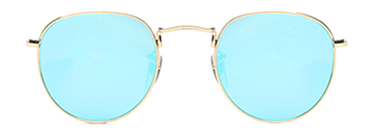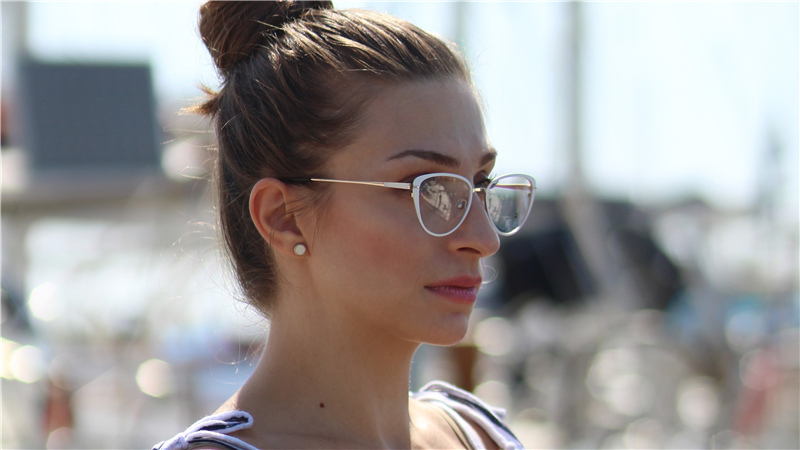
It is really not a Yes or No question
Since their introduction, progressive lenses have primarily addressed the visual difficulties of middle-aged and elderly individuals who struggle to see both near and far. For those with simple presbyopia and only require glasses for close-up tasks, reading glasses can suffice. However, if someone has both nearsightedness and presbyopia, wearing just one pair of glasses causes issues when attempting to see at various distances—be it near or far. A single pair of glasses can't effectively address the challenges of clear vision at different distances.
Most importantly, the progressive eyeglasses can protect wearer’s age privacy and avoid age discrimination from society.
Having one pair of glasses with progressive lenses is generally considered the more convenient option, as it allows you to see clearly at all distances (near, intermediate, and far) without constantly switching between multiple pairs of glasses.
Progressive lenses are designed to gradually change in power from the top of the lens (for distance vision) to the bottom of the lens (for near vision), which allows for a more natural and seamless transition between distances.

On the other hand, having two separate pairs of glasses—one for distance (like for driving or watching TV) and another for reading or close-up work—can provide more specific and optimized vision correction for each task. Some people find this method more comfortable and easier to adapt to, especially if they have difficulty adjusting to progressive lenses.
It's important to note that not everyone can easily adapt to progressive lenses, and they may not be suitable for everyone to wear
In the screening for the adaptation of multifocal progressive lenses, it's evident that they are not suitable for certain groups of people
Progressive lenses may not be suitable for everyone, especially in cases where individuals have certain visual conditions or preferences. Some specific scenarios where progressive lenses might not be recommended include:
- Any Older Patients who have the probability to fall down
- Individuals with abnormal body posture or eye positions who cannot move their head and freely
- Special occupations with visual demands that don't align with the design of progressive lenses
- Anisometropia in the eyes
- High refractive errors
- History of difficulty adapting to glasses
- Insufficient corrected vision
Any People Especially Older Patients who have the probability to fall down
Falls, often underestimated, account for a large portion of accidental deaths and nonfatal injuries globally. In the US, at least one-third of healthy adults aged 65 or older fall at least once a year. For those aged 90 or older, the risk increases to about 60 percent.
From the elderly to young children, everyone faces potential risks associated with falls. The impact can range from minor injuries to fatal consequences.
Several factors contribute to falls, including environmental hazards, health conditions, and age-related risks. Identifying and mitigating these factors play a crucial role in preventing fall-related accidents.
The decline in vision is a significant risk factor, indicating that corrective measures for vision, especially correct vision glasses and cataract surgery can reduce the risk of falls. However, surprisingly, most studies indicate that the occurrence of falls among elderly individuals who receive new vision correction is rarely or not reduced at all.
Dr. Elliot suggests that the magnification effect of some new eyeglasses provided in a study might lead to an increased risk. "The prescription changes significantly for some participants and elderly individuals who are frail may find it harder to adjust to these changes, increasing the risk of falls during the adaptation period."
An unfamiliar magnification factor may cause objects to appear closer or farther than their actual distance, affecting the connection between the balance system and eye movement reflexes. For elderly patients unaccustomed to bifocal and "progressive" lenses (where areas for near and distant vision correction differ), switching to these types of lenses may result in peripheral vision distortion.
For People Especially Elder Patients at Risk of Falling - "If it Isn’t Broken, Don't fix it."
So, if maximizing visual correction doesn't address the issue, what can optometrists do to help prevent the risk of falls in elderly patients? The crucial first step is to assess risk factors, including fall history, medical conditions, and medication use.
Taking a "conservative" approach by fitting new eyeglasses for elderly individuals with a history of falls or fall risk factors.”If it Isn’t Broken, Don't fix it” is an appropriate clinical adage."
Sticking in the same type of lenses (bifocals, progressive lenses, etc.) and your vision habits, unless there's a significant reason to change. For patients accustomed to wearing single-vision glasses and may have a risk of falling, be careful to switch to progressive or bifocal glasses. Change is a big challenge for our brain, especially the elderly brain. Brain needs time and energy to build new connections and circulation among brain nerve cells. If you are customized to two pairs of glasses for far and near, just keep it.
Individuals with Abnormal Body Posture or Eye Positions Who Cannot Move Their Head and Eye Freely
We know that progressive lenses are designed with specific zones, requiring the movement of head or eye positions to utilize the corresponding areas for vision. Therefore, people who cannot easily move their head positions are not suitable for wearing these lenses. This includes individuals with conditions such as limping, short neck, short stature, cervical spondylosis, shoulder arthritis, spinal diseases, spinal curvature, and strabismus.
Individuals with motor system disorders or poor balance
People with motion sickness, vertigo, or similar dizziness symptoms, as well as those with inner ear functional impairments, may experience exacerbated dizziness symptoms when wearing progressive lenses. Hence, they are not suitable candidates for wearing progressive lenses.
Special Occupations With Visual Demands that Don't Align with the Design of Progressive Lenses
Different professions entail varying visual requirements. In the fitting of progressive lenses, it's important to understand occupations with visual demands that do not align with the design of upper-far and lower-near vision of these lenses.
- Individuals requiring near vision when looking upwards are not suitable, such as librarians, pilots, and plumbers.
- Individuals needing distance vision when looking downwards are not suitable, like construction workers or those involved in high-altitude tasks. Additionally, professions with broader field of view requirements, frequent head movements, or heavy reliance on peripheral vision, such as tennis players, piano performers, are also unsuitable.
Anisometropia in the eyes
For individuals with a difference in refractive power between the two eyes, where the spherical power is greater than ±2.00 diopters and astigmatism is greater than ±2.00 diopters in either eye, especially those with a vertical difference of over 2.00 diopters, notably individuals with oblique astigmatism. Due to significant refractive power differences in both eyes, these individuals experience an intolerable prism effect. During reading, not only do both eyes converge, but the lower part rotates towards the nasal side, causing a slight variation between the astigmatic axis for near and far vision. When astigmatism is too high, it can affect the correction of near vision astigmatism.
High refractive errors
High refractive errors cause excessive distribution of progressive multifocal point images, leading to potential discomfort in wearing.Normal distance vision without previous experience of wearing glasses and a strong desire for high expectations when wearing glasses: Customers of this nature typically show a lack of willingness to wear glasses for distance viewing but hope that wearing progressive lenses will restore their vision to a state where they can effortlessly see objects at all distances, similar to before aging. The success rate of fitting progressive multifocal lenses for such patients is relatively low.
Insufficient corrected vision
Individuals with low vision correction, such as amblyopia or corrected visual acuity below 0.6, might struggle to meet the visual demands of wearing progressive lenses.
History of difficulty adapting to glasses
Individuals with a history of sensitivity and poor adaptability to glasses should be screened for difficulties in adapting to refractive power or frame fitting when considering progressive multifocal lenses. It's advisable to avoid recommending these lenses whenever possible.
Previous frequent users of bifocal glasses: Individuals accustomed to bifocal glasses, which have a larger near-vision area compared to the smaller near-vision area in progressive lenses, might find the transition challenging. Additionally, as this group often has slightly higher ADD, the image distortion in the progressive multifocal area might be more pronounced. Customers with high near-vision needs should be carefully recommended for progressive lenses.
If you do not have the above problems, We strongly recommend you to wear progressive lens glasses
Protect your age privacy and avoid age discrimination
The lens looks like a single vision lens and does not see the dividing line of the degree change like bifocals lenses. Nor do you need to change your glasses when you switch to near mode. Not only is it beautiful, but more importantly it protects the wearer's age privacy (for reading glasses wearers), and there is no need to worry about leaking the age secret by wearing a mirror.
Age discrimination refers to the unfair treatment or prejudice against an individual or a group of individuals based on their age. This discrimination can occur in various aspects of life, particularly in the workplace, where individuals may face bias, stereotyping, or exclusion due to their age.
Although nobody will concede that they discriminate against older people, however, people cannot sense they discriminate against older people because it is in their subconscious.
More than 40% of workers over the age of 40 say they've experienced age discrimination at work in the last three years, according to a recent AARP survey. They exist in almost every aspect of the workplace such as job interviews, promotion and salary and benefits. We can not change society, and have to accept that age discrimination is there. However, we change ourselves by wearing progressive lens glasses and dressing young and keeping our bodies young.
“Fashion is an instant language” Miuccia Prada
The line of bifocals can not be fashionable, because it implies you are older. It is a stereotype in people’s subconscious. progressive lenses, just like single vision glasses, protect the wearer's age privacy (for reading glasses wearers), and there is no need to worry about leaking the age secret by wearing a mirror.
The suitable fashion glasses not only have the function of correcting vision, but also enhance the appearance and hiding the defects of the facial features. Research shows that suitable Glasses can increase the success rate of prescription glasses wearers dating by 50%.
Most people judge people just by looking at their appearances because that's the first thing visible to us. “Image determines influence” Dressing is an art of “deception”. A person can be "face". Generally speaking, his "appearance" can partially or largely see what kind of person he is.
With the progressive lens, you have the room to play your fashion game like,
Frame Styles for Face Shape
Frame color , lenses color and your skin coordination
Glasses and your dress, hat and scarf
I do not want to talk about the fashion aspect of the glasses too much. If you are interested, please please click here.



